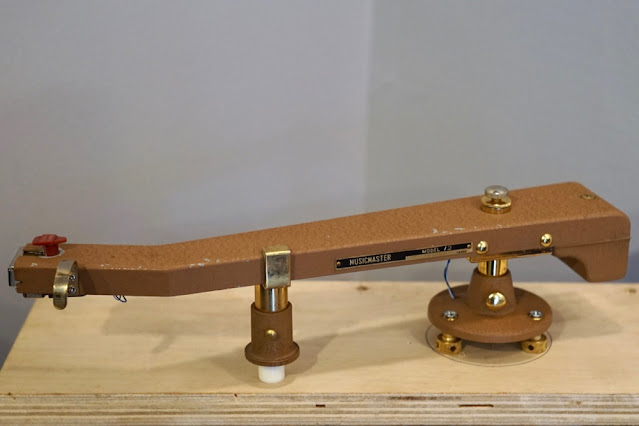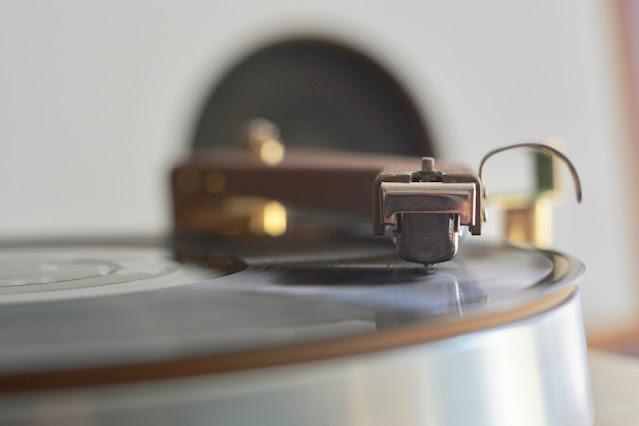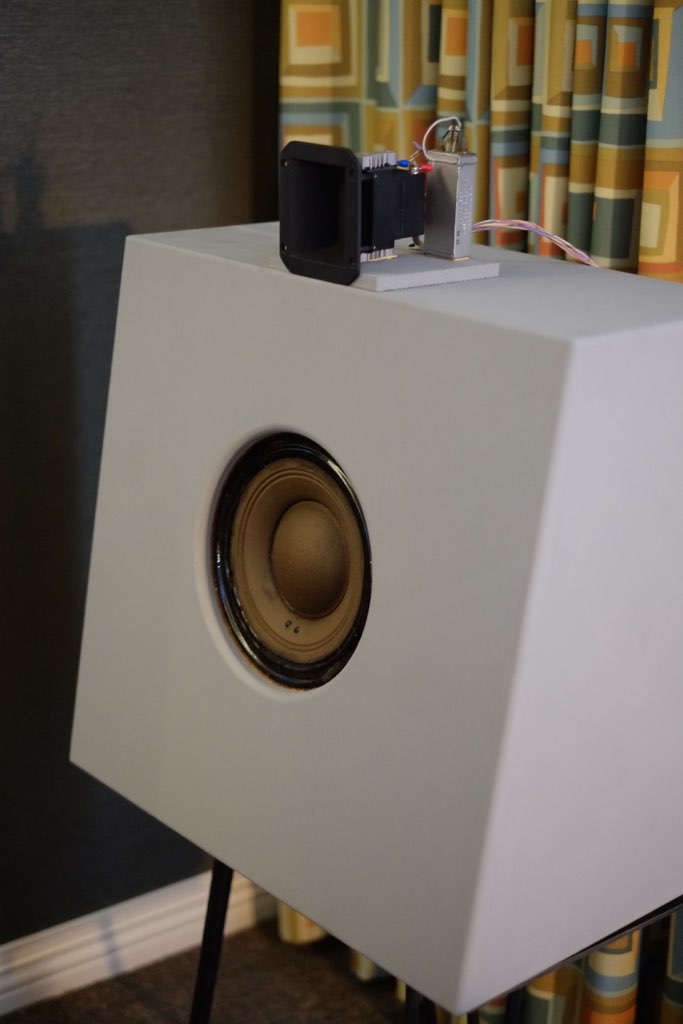Over two decades ago, I ventured into single channel music reproduction to trace the roots of high fidelity. From that whole experience, I developed an aesthetic quest for a certain purity and honesty in sound, which runs parallel with my other hobby of black and white film photography! Sadly, I had to leave that particular mono set up in the attic in 2017.
Sunday, October 6, 2024
Friday, August 4, 2023
General Electric A1-400 Speaker
 |
| GE A1-400 specs |
As stated in the spec sheet, the perforated metal grill functions as a mechanical roll off filter for the 12" driver and the non-polarized wax and paper capacitor filters frequencies below 1800 Hz from reaching the 2 3/4" cone tweeter.
I also recognized this period correct DIY tuned pipe enclosure designed for corner placement. It was built based on an article published in the May 1955 issue of Audio (go to page 18), authored by Norman H. Bates.
BTW, AFAIK, he's not related to the lead character in Hitchcock's thriller. 🤣
Vocals are nicely rendered! The transition between the low and high frequency drivers is very coherent, as to be expected between two paper coned transducers. If I were forced to split hairs, I hear a tinge of nasal coloration in the lower region of male vocals, which I never notice with any of my Altec speakers.
I guesstimate its sensitivity to be in the high 90s/W/M because it'll boogie, driven by the 1250 mW SE triode connected 46 or 1500 mW SE10 amp. Although I can also listen to my Altec mini 757 with those aforementioned amps at respectable SPLs, it needs at least an SE2A3 for full dimensional monaural listening pleasure.
Kudos to Mr. Bates' corner loaded tuned pipe cabinet for the aforementioned impressive bass performance and my perceived easy-to-drive/high sensitivity nature of this speaker system. Kids, this enclosure was designed during the slide rule era!👍
Now I'm inspired to pursue my 285mW SE112A mono amp project.😊
.
After 21 years of hunting, I finally got a satisfying taste of the GE co-ax. I've seen this on eBay between $150-175, which I believe is a fair price for a unit with intact cones and no voice coil rubbing. A couple of my Instagram contacts even expressed fondness and admiration for this speaker when they saw a glimpse of it in my posts!
I now regret leaving my RCA 501-S1 in the attic 😔 because it would have made for a very interesting shootout. If I can trust my sonic memory though, the RCA didn't have the nasal coloration in the lower midrange I noted earlier. OTOH, the top end of the RCA could be deemed more reticent or refined depending on the listener's taste.
 |
| I debated whether to refinish the cabinet but the patina grew on me.😊 |
In the context of my monaural hi-fi system, it shall remain second only to the Altec mini 757 because when I played a young Sinatra LP for my buddy Ding, he initially thought it was Bing Crosby.😄 Sinatra only sounds like Sinatra LIVE or on an ALTEC!👍😎
Let's see what the gentlemen at Stereo Sound thought of its younger A1-401 brother two decades ago...
Saturday, April 15, 2023
Saturday, March 18, 2023
Musicmaster Model 12 (Gray clone) Tip + GE VRII Hack
 |
| Canon P + Canon 50mm f1.8 Foma 100 in Rodinal 1+50 |
After many decades of collecting and using classic audio equipment and film cameras, I've learned to accept that sometimes I win, sometimes I lose, but most of the time I break even. And the only reason there is that possibility of breaking even is because I learned to DIY.
This tonearm came with a KS Musicmaster Model 25B12GST idler-driven turntable, which I thought I could resuscitate. Alas, the turntable was beyond saving because a lot of important parts were missing. The tonearm had no head shell slide and the cartridge pin contact points + wiring harness were gone. For many years this tonearm was boxed up along with other parts units sitting in storage.
One day I had an epiphany - will the Karmadon head shell slide fit?
I'm happy to report that the two types of head shell slides that my buddy, Sergiy, manufactures for his Gray Research tonearm clone work on this Japanese clone as well as on my original Gray Research 108C. Above left is a solid shell and on the right is a shell with a hole to accommodate the triple play feature of the General Electric RPX and VRII mono cartridges.
Despite the carnage brought upon the Ukrainians by a deranged autocrat, my Karmadon head shells arrived in less than two weeks. We really have to admire and support these people!
I rewired the tonearm and blu-tacked 4 pennies to make up for the lost hardware.
Since the Karmadon head shell slide is lighter than the original, I used all three copper weights Sergiy provided, added 2 x 5 centavo coins + the GE VRII cartridge = 25 grams.
Voila!👍
 |
| For more viscous damped tonearm set up information, please click here! |
Even with my 20+ years of experience using this tonearm, it took me a while to dial-in the proper weight compensation due to the missing hardware + adapted head shell slide. Getting a viscous damped tonearm to function properly isn't for the faint of heart and requires patience. If you don't possess these virtues, I suggest you don't consider using one. But I must say the results are well worth it!😊
 |
| Musicmaster Model 12 + GE VRII |
Let's listen to a few monaural hifi tunes!
🎶🎻🎹🎷
Friday, April 8, 2022
Altec 756B + 32C + 806 + 23744 = mini 757
The WE756A is the middle child in the Western Electric series of wide range drivers introduced in the late 40s.
I've seen and heard a couple of WE/Altec 728Bs + a dozen or so pairs of 755As, but I've never heard a WE756A and have only seen one in the metal at a radio show many years ago. Although still quite scarce, its Altec 756B brother isn't quite as elusive.
 |
| Back: Blonde + Mahogany Altec Melodist 700A Front L-R : WE728B, Altec 755A/pr. + Altec 756B |
The few Altec 756Bs I've encountered all came out of the Altec Melodist 700A. It's a compact bass reflex speaker system loaded with the 756B, supplemented on top by a 3000A horn tweeter via an N3000B crossover. The 700A belonged to the Melodist monaural hifi system line, which Altec targeted at apartment dwellers in big cities of midcentury America.
Subsequently, the 756B was replaced by an 8" Altec 401A and was re-designated as the Melodist 700B. With the introduction of stereo for the mainstream market in 1958, the Altec Melodist line quietly faded into oblivion.
If found in good condition, the Altec Melodist 700A is a fine looking midcentury modern artifact! Unfortunately, the < 1.5 cf ported box doesn't allow the 756B to shine sonically, IMHO. Since it shares similar proportions to its more successful contemporaries like the Acoustic Research AR-1 and the Jensen Duette, the cabinet design may have been dictated by market positioning rather than sound engineering.
My once-in-a-lifetime lucky find 700A above has lived a hard life. The lower front edge of the cabinet was missing while the sweet and airy but very fragile 3000A horn tweeter element had been replaced by a tiny ferrite magnet dome tweeter.😏 A "mod" that has been circulating in the internet, so watch out.
Fortunately, the 756B is very well preserved. If memory serves me right, the WE756A frame is more substantial than the Altec 756B. That’s probably the reason why the back handles were omitted in the Altec. The 756B has an 8 ohm voice coil, while the WE756A is 4 ohms.
 |
| J-Rob's Altec 756B at Capital Audio Fest 2016 |
Joe Roberts has already done a great job of describing the sonic qualities and proper implementation of the Altec 756B in his (Geekstar) "My big ten inch --Altec 756B" post at the Altec User's Board. He also gave insight on the shifting Asian market for vintage Western Electric and Altec gear. A guaranteed fun and informative read!
Since I don't have Joe's networking skills, I resigned myself to the reality that my Altec 756B will be the main speaker of my monophonic hi-fi set up, just as Altec intended.
 |
| Click for a videoclip |
Meanwhile, I repurposed (sealed) a Heathkit AS10 (almost 2 cf) cabinet to familiarize myself with the 756B. I listened to it as a wide range driver with and without top end assistance from either a 32A/802/34852 + an XO based on this schematic or 3000H with an L-Pad + 0.5 uf - 1 uf paper in oil cap. The simplest XO I used was a 0.22uf paper in oil cap in series with the + terminal of the 3000H, no L-pad needed. That also sounded good, albeit, with slightly less sparkle.
 |
| JE Labs mini 757 inspired by the Western Electric 757A |
After extensive listening in wide range mode, I determined that a mono hifi set up will benefit from a wider baffle + the dispersion pattern of the Western Electric-derived 32 horn. So I sketched a slant front ~ 2.5 cf infinite baffle that has a provision for an Altec 32C horn + 802 driver and sent it to John Piro of Hommage Audio.
 |
| 728B vs. 756B |
As expected, the 756B is more extended at the top end than the 728B with almost, but not quite, equal bass extension. However, music through the 728B held my attention appreciably longer without my reaching for a clip-lead to fill in the top octaves with the 32/802 horn/driver for more harmonic overtones above 5 kHz.
 |
| RTA = Altec 756B in a ~ 2.5 cf infinite baffle |
I confirmed this during one of my shop talks with J-Rob, who also found it more rewarding to listen to 728Bs in wide range mode than to his 756Bs. It makes me wonder if the 756B and its WE756A brother were designed with a middle-child syndrome gene in their sonic DNA.🤔
After many years of collecting Altec 1" compression drivers, I've only landed a single Altec 23744 "light" aluminum diaphragm, which was fitted to an 806 motor that was used in the Altec 9849 monitor speaker.
Things started to crystalize when my friend Dave V. aka Salectric,🙏 sent me his spare .085 mH choke. It was a proprietary part found in the EQ circuit of the Altec 9849 crossover, which is an 8 ohm speaker system. This EQ circuit shapes and boosts the response of the 32/806 horn/driver combo. Incidentally, Dave's "Last PAS" articles written for The Audio Amateur contributed to my 80s Dynaco hacking activities.
 |
| RTA = Altec 32C + 806 + 23744 |
The 4 uf paper in oil capacitor serves as a first order high pass filter hinged around 5 kHz with a gentle 6dB/octave slope, while the variable 8 ohm L-pad shapes and controls upper frequency overtones to taste.
 |
| inside the mini 757 |
John P did a great job of building a very rigid cabinet, which saved me the time and trouble of having to experiment with damping. I just lined the interior panels with Kimpak and I was ready to listen.
 |
| RTA = JE Labs mini 757 |
This project transpired as an opportune moment to assemble all the singleton Altecs from my collection - 756B + 32C + 806 + 23744 - into a formidable monaural hifi speaker system.😊
 |
| JE Labs mini 757 |
My ears hear close to half an octave of bass extension from the mini 757 compared to the 755A in a Silbatone or 618 cabinet. Due to its greater efficiency, it plays louder while dynamics at micro and macro levels are less compressed. The larger cone area of the 756B + wide baffle + 90° horizontal x 60° vertical dispersion of the 32C horn, portray a bigger sense of scale. All of these were achieved without compromising the midrange realism I enjoy from my beloved 755A.
However, the Altec 753C is perceptibly more efficient, offers at least an octave lower of extension with more authority. It also produces higher SPLs.
Alas, we can't defy the physics of sound...
 |
| JE Labs monophonic hifi |
...so I focused on the aesthetics by spicing it up with a touch of Charles Eames and Dieter Rams! 😉
Tuesday, January 4, 2022
Begin the Beguine 2022
 |
| GE "single stud" RPX + 3 mil sapphire stylus in a Karmadon slide shell |
Thursday, August 19, 2021
Gray Research HF500 Turntable + 108C Tonearm
My buddy John Piro has a knack for finding obscure vintage hifi pieces and has built up quite a collection. A couple of summers ago, he offered his spare blonde plinthed HF500.
I had just acquired my first and only genuine Gray Research 108C viscous damped tonearm and couldn't pass up the opportunity to pair them up.
 |
| Capstan Drive |
 |
| 45 + 78 rpm capstans |
 |
| D&R turntable drive system Courtesy of jamesvanarsdale.com |
 |
| Seiko-Epson drive system Courtesy of audio-heritage.jp |
Servicing Tips
Disassembly
Removing the motor
 |
| Left = worn out motor mounts Right = fresh motor mounts |







































